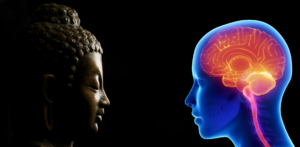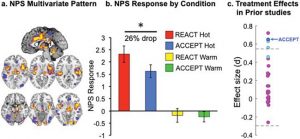
The Variety of Meditation Experiences
By John M. de Castro, Ph.D.
“One can have almost any type of physical sensation during meditation in any area of the body. . . The ticklish sensation in your heart just means that some normalization is occurring there, allowing for a more full expression of your emotions. The sense of anxiety or fear is a by-product of that clearing process.” – Depak Chopra
Meditation is a wonderful practice that has many documented beneficial effects on mental, physical and spiritual health. For the most part, people have positive experiences during meditation, but it is not all positive. People begin meditation with the misconception that meditation will help them escape from their problems. Nothing could be further from the truth. In fact, meditation does the exact opposite, forcing the meditator to confront their issues. In meditation, the practitioner tries to quiet the mind. But, in that relaxed quiet state, powerful, highly emotionally charged thoughts and memories sometimes emerge.
Many practitioners never experience these issues or only experience very mild states. There are, however, few systematic studies of the extent of negative experiences. In general, the research has reported that unwanted (negative) experiences are quite common with meditators, but for the most part, are short-lived and mild. There is, however, a great need for more research into the nature of the experiences that occur during meditation.
In today’s Research News article “The varieties of contemplative experience: A mixed-methods study of meditation-related challenges in Western Buddhists.” (See summary below or view the full text of the study at: https://www.ncbi.nlm.nih.gov/pmc/articles/PMC5443484/ ),
Lindahl and colleagues recruited experienced adult meditation practitioners and teachers from a variety of different traditions. Meditators were excluded if they had a history of unusual psychological experiences prior to learning meditation. They conducted extensive semi-structured interviews that consisted of open-ended questions regarding meditation-related experiences. Interviews with the participants were conducted either in person, by videoconferencing, or by telephone. Transcripts of the interviews were then subjected to qualitative data analysis focusing on challenging or difficult experiences.
They found that most practitioners had experienced at least some challenging experiences. 29% encountered challenges in their first year of practice while 45% encountered them in their first 10 years. For 73% of the practitioners, challenging experiences were associated with meditation retreats, while the rest were associated with daily practice. The more meditation per day the greater the likelihood of negative experiences with only 25% who practiced for 30-60 minutes per day having negative experiences, 34% who practiced 1-9 hours per day, and 41% who practiced over 10 hours per day. One of the most striking findings was the duration of negative experiences. They were not brief or fleeting. In fact, on average they were reported to persist from 1 to 3 years and as long as 10 years.
Thematic content analysis of the transcripts revealed 59 different categories of experiences that occurred in 7 higher order domains; cognitive, perceptual, affective, somatic, conative, sense of self, and social. 73% of practitioners had experiences falling into at least 6 domains.
The Cognitive Domain consisted in “Changes . . . to mental functioning, including the frequency, quality and content of thoughts, as well as . . . planning, decision-making and memory.” Most experiences in this domain were pleasant but unpleasant experiences also occurred including inability to concentrate for extended periods, problems with memory, the disintegration of conceptual meaning structures, “mind racing,” vivid imagery, and delusional, irrational, or paranormal beliefs.
The Perceptual domain consisted of ”changes to any of the five senses: vision, hearing, smell, taste and somatosensory processing” and interoception and proprioception. Unpleasant experiences in this domain included hypersensitivity to stimuli, illusions, hallucinations, dissolution of perceptual objects, distortions in time and space, and sensations appearing dreamlike, as if in a fog.
The Affective domain consisted of changes in the type, frequency, or intensity of emotions. For many the affective experiences were pleasant including bliss and euphoria, sometimes verging on mania. But, unpleasant experiences were very frequent and involved both increased and decreased emotionality including anxiety fear, panic, re-experiencing trauma, irritability, anger, and paranoia with 82% reporting it. For some flat affect occurred with a loss of swings in emotion.
The Somatic domain consisted of “changes in bodily functioning or physiological processes.” Unpleasant experiences in this domain included sleep disruption, feelings of pressure, tension, and hot and cold, electricity like voltages or currents through the body sometimes resulting in involuntary movements.
The Conative domain consisted of “changes in motivation or goal-directed behaviors.” Unpleasant experiences in this domain included loss of desire for previously enjoyed activities and loss of motivation to achieve goals.
The Sense of Self domain consisted of “changes in how a practitioner conceives of himself or herself over time.” Unpleasant experiences in this domain including a dissolution of boundaries between the individuals and others and the environment, loss of a sense of ownership of thoughts, emotions and agency (the doer), and loss of a sense of self entirely.
The Social domain consisted of “changes in interpersonal activities or functioning, including level of engagement, quality of relationships, or periods of conflict, isolation or withdrawal.” Unpleasant experiences in this domain included problems re-integrating into society after a retreat or intensive practice, impaired functioning at work or with family, and doubt and loss of faith. In fact, many of the negative experiences bled over into everyday life affecting all social interactions.
These findings need to be kept in perspective as most experience with meditation are pleasant and positive and even the negative experiences are mainly brief and manageable. But the results emphasize that it’s not all what people are led to believe. It can turn unpleasant or even ugly. It is important that this be taught and managed in the meditation community. In the monasteries this is well understood and managed. But in the secular world, these negative experiences are rarely taught, understood, reacted to properly, or managed. For many negative experiences can lead to stopping practice, but for others they can lead to grave psychological harm. It is important that the practitioner be made aware of these possible experiences before they begin, so they are better able to understand them a handle them astutely.
Meditation should not be engaged in blindly without proper instruction. It can produce great benefit but sometimes great harm. In order to maximize the benefits and minimize the harm proper education and management is needed.
“Emotions that come up during meditation represent one of two things: 1) undigested past negative emotions that are rising up to be processed, or 2) a present-moment experience of raw emotion from something happening now, which can be positive or negative. Either way, it can make for an uncomfortable meditation and is one of the most common reasons people stop meditating.” – Trista Thorp
CMCS – Center for Mindfulness and Contemplative Studies
This and other Contemplative Studies posts are also available on Google+ https://plus.google.com/106784388191201299496/posts and on Twitter @MindfulResearch
Study Summary
Lindahl, J. R., Fisher, N. E., Cooper, D. J., Rosen, R. K., & Britton, W. B. (2017). The varieties of contemplative experience: A mixed-methods study of meditation-related challenges in Western Buddhists. PLoS ONE, 12(5), e0176239. http://doi.org/10.1371/journal.pone.0176239
Abstract
Buddhist-derived meditation practices are currently being employed as a popular form of health promotion. While meditation programs draw inspiration from Buddhist textual sources for the benefits of meditation, these sources also acknowledge a wide range of other effects beyond health-related outcomes. The Varieties of Contemplative Experience study investigates meditation-related experiences that are typically underreported, particularly experiences that are described as challenging, difficult, distressing, functionally impairing, and/or requiring additional support. A mixed-methods approach featured qualitative interviews with Western Buddhist meditation practitioners and experts in Theravāda, Zen, and Tibetan traditions. Interview questions probed meditation experiences and influencing factors, including interpretations and management strategies. A follow-up survey provided quantitative assessments of causality, impairment and other demographic and practice-related variables. The content-driven thematic analysis of interviews yielded a taxonomy of 59 meditation-related experiences across 7 domains: cognitive, perceptual, affective, somatic, conative, sense of self, and social. Even in cases where the phenomenology was similar across participants, interpretations of and responses to the experiences differed considerably. The associated valence ranged from very positive to very negative, and the associated level of distress and functional impairment ranged from minimal and transient to severe and enduring. In order to determine what factors may influence the valence, impact, and response to any given experience, the study also identified 26 categories of influencing factors across 4 domains: practitioner-level factors, practice-level factors, relationships, and health behaviors. By identifying a broader range of experiences associated with meditation, along with the factors that contribute to the presence and management of experiences reported as challenging, difficult, distressing or functionally impairing, this study aims to increase our understanding of the effects of contemplative practices and to provide resources for mediators, clinicians, meditation researchers, and meditation teachers.
https://www.ncbi.nlm.nih.gov/pmc/articles/PMC5443484/









